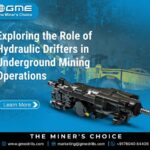When it comes to extracting valuable minerals from the earth, choosing the right method and tools is crucial. In this blog, we’ll explore the differences between surface mining and underground mining, focusing on their respective pros and cons. At Global Mining Equipments, we offer a wide range of **underground mining tools and equipment** to suit your specific needs.
Surface Mining – Pros
1. Cost-Effective: Surface mining is generally cheaper than underground mining. The infrastructure and operational costs are lower because it involves less sophisticated technology and labor.
2. Higher Recovery Rate: Surface mining allows for the extraction of a larger portion of the mineral deposit. This method often results in a higher recovery rate compared to underground mining.
3. Safety: The risks associated with surface mining are relatively lower than those in underground mining. Workers are less exposed to the dangers of cave-ins, explosions, and toxic gases.
Cons
1. Environmental Impact: Surface mining can cause significant environmental damage. The removal of large areas of land and vegetation can lead to soil erosion, habitat destruction, and water pollution.
2. Limited Depth: Surface mining is not suitable for deposits located at great depths. As the depth of the deposit increases, the cost and complexity of surface mining also increase, making it less feasible.
3. Visual Impact: Surface mining operations often result in large, unsightly scars on the landscape, which can be a concern for communities and local governments.
Underground Mining – Pros
1. Less Environmental Impact: Underground mining has a smaller environmental footprint compared to surface mining. It causes less disruption to the surrounding land and ecosystems.
2. Access to Deep Deposits: This method is suitable for extracting minerals located deep beneath the earth’s surface. It allows for the efficient extraction of high-value deposits that are not accessible through surface mining.
3. Long-Term Operation: Underground mining operations can be maintained for longer periods, making them ideal for projects with a long-term horizon.
Cons
1. Higher Costs: The costs associated with underground mining are typically higher. The need for specialized underground mining tools and equipment, as well as additional safety measures, contributes to the increased expenses.
2. Safety Risks: Underground mining poses significant safety risks to workers. The potential for cave-ins, gas explosions, and flooding requires stringent safety protocols and constant monitoring.
3. Complex Operations: The logistics of underground mining are more complex. Transporting workers, equipment, and extracted materials to and from the surface requires advanced systems and infrastructure.
Choosing the Right Mining Method
The choice between surface mining and underground mining depends on various factors, including the depth and type of the mineral deposit, environmental considerations, and economic viability. At Global Mining Equipments, we specialize in providing high-quality **underground mining tools and equipment** that are designed to enhance safety, efficiency, and productivity.
In conclusion, both surface mining and underground mining have their advantages and disadvantages. Surface mining is cost-effective and has a higher recovery rate, but it can cause significant environmental damage. On the other hand, underground mining is less disruptive to the environment and allows access to deep deposits, but it is more expensive and poses greater safety risks. When it comes to underground mining tools and equipment, Global Mining Equipments is your trusted partner.
Get Free Quote today! Contact us at +91 7604084406 or email us at marketing@gmedrills.com. Our team at Global Mining Equipments is here to help you find the best solutions for your mining needs.




Leave a Reply